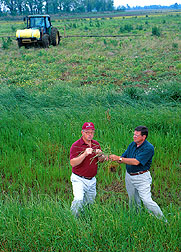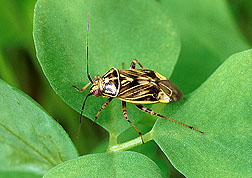Banishing Tarnished Plant Bugs From Cotton
|
|
The tarnished plant bug doesn't have anything else to blame for its notorious reputation. This pest has been causing farmers trouble for a long time and doesn't seem likely to clear its name. In fact, like its "partners in crime"—tobacco budworm and cotton bollworm—it was recently added to the list of cotton pests that are showing resistance to insecticides. This isn't good news for cotton growers.
"Cotton is a major cash crop in the Mississippi Delta region, and farmers simply can't afford to add another damaging pest to the list," says entomologist Gordon L. Snodgrass. He is in ARS' Southern Insect Management Research Unit at Stoneville, Mississippi.
In August 1993, Snodgrass discovered that tarnished plant bugs, Lygus lineolaris, had become resistant to pyrethroids, a class of insecticides commonly used to control them.
Plant bugs are a particular problem, because there are more than 100 different weed species on which they can feed and reproduce, Snodgrass says. In winter, the bugs lie dormant in weeds surrounding cottonfields. Then, from February to late March, they emerge and begin laying eggs in the weeds. In late spring, when the weeds mature, the bugs move to cotton crops.
"This is a weak point in their life cycle," Snodgrass says. "We want to stop population buildups by breaking their cycle early in the season, before they move into cotton."
Not to be confused with the western tarnished plant bug—a widespread pest west of the Rockies—the eastern tarnished plant bug feeds on many vegetable, fruit, and ornamental crops throughout the United States and Canada.
Snodgrass says the pest could reverse the trend in areas where a boll weevil eradication program is in full swing. Farmers have been able to cut down on sprayings for boll weevils, but they would have to continue or resume spraying for plant bugs.
Concern about this cotton pest—which cost $75 million last year in control measures alone—has led to the ARS areawide tarnished plant bug project.
A 3- to 4-year study that began last summer, the project currently consists of four 9-square-mile areas in the Mississippi Delta, with a possibility of future expansion.
The goal is to find if controlling weeds early in the season can prevent damaging numbers of plant bugs from invading cotton later on.
Enlisting Grower Support
|
|
In the first test last summer, Snodgrass and entomologists William P. Scott and D.D. Hardee, who heads the insect management research unit, mowed or applied certain herbicides to control weeds. They reduced weed density in the treated areas, causing a sharp reduction in tarnished plant bugs compared to untreated areas.
"This project involves a major cooperative effort between ARS and Mississippi State University Delta Branch and Extension Center," says Scott, who is also in the Stoneville unit. "Through USDA's Farm Service Agency, we identified about 60 growers in the test areas and asked them to participate in the project. They were very cooperative, allowing us to spray herbicides and survey their fields. Farmers realize tarnished plant bugs are a serious pest, and they have to rely totally on insecticides to control them."
Another approach to helping growers protect their cotton from the bugs is integrated biological control, says biological control specialist Livy H. Williams, also in the Stoneville unit. His research focuses on improving the physiology and behavior of beneficial insects to make them more effective against pests. Strategies include developing better ways to rear and release beneficials and providing food sources and shelter to help them survive in the field.
Williams says applying pesticides makes it difficult to use natural enemies of pests, since "good guy" insects succumb to the same insecticides that kill bad ones. "Finding ways to manipulate a suitable environment for natural enemies to persist and survive is a major challenge," says Williams. "One way of doing this is targeting our efforts when the tarnished plant bugs are on their spring weed hosts, before they move into cotton."
Parasitic Wasps and Other Insect Allies
Williams says they've identified a tiny wasp parasitoid, Anaphes iole, which is widespread in North America and has been used in California to control western plant bugs. The wasp pierces tarnished plant bug eggs and lays its own egg inside—killing the plant bug and regenerating its own population. It doesn't bother other insects or animals.
"For the wasps to be abundant in the spring," Williams says, "we need an alternate host for them in winter, when plant bugs are in the adult stage. The wasps attack only the eggs, and plant bug eggs are scarce until spring. Ideally, wasps should emerge in the spring before pesticides are sprayed."
|
|
Williams and others at Stoneville have identified several plant bug predators, including minute pirate bugs, green lacewings, and big-eyed bugs. With the help of ARS' Biological Control and Mass Rearing Research Unit in Starkville, Mississippi, Williams is evaluating the effectiveness of the wasps and several plant bug predators. The unit is headed by entomologist Donald A. Nordlund.
Starkville scientists are working on artificial diets for the tarnished plant bug and some of its predators.
In another control strategy tried last summer, Snodgrass and Scott were looking at male and female attraction to sticky traps baited with either live males or females. To their surprise, they discovered that the males may produce a perfumelike pheromone that attracts both sexes—probably to signal food sources.
"Male-baited traps caught both. We think there's a pheromone, but we need to repeat the test this summer to make sure," Snodgrass says.
Meanwhile, they've been working with ARS' Insect Chemical Ecology Laboratory in Beltsville, Maryland, to identify a female pheromone, so that a synthetic lure can be developed to bait traps.
"The tarnished plant bug is the only major cotton pest for which we don't have a sex pheromone," Snodgrass says. Once the scientists develop one, they'll be much closer to banishing the pest from U.S. cottonfields.—By Tara Weaver-Missick, Agricultural Research Service Information Staff.
This research is part of Crop Production, Product Value, and Safety, an ARS National Program described on the World Wide Web at http://www.nps.ars.usda.gov/programs/cppvs.htm.
Gordon L. Snodgrass, William P. Scott, Livy H. Williams, and D.D. Hardee are in the USDA-ARS Southern Insect Management Research Unit, P.O. Box 346, Stoneville, MS 38776; phone (601) 686-5231, fax (601) 686-5421.
"Banishing Tarnished Plant Bugs From Cotton" was published in the July 1999 issue of Agricultural Research magazine.









